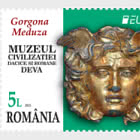Dinosaurs from Hateg County – Romania
Romfilatelia, the company specialized in issuing and trading Romanian postage stamps, releases an issue dedicated to the natural patrimony of Romania, called Dinosaurs from Hateg County.
Hateg County (Tara Hategului) lies between the Retezat Mountains and the Sureanu Mountains and it is well renowned for the beauty of its landscapes, but also for its archaeological and historical vestiges, its old churches and its folk traditions.
The traces of several dinosaurs species discovered here add a certain special interest to this land. The dinosaurs from Hateg County are famous all around the world and they also appear in the documentaries of the Discovery Channel due to some peculiar aspects: they made up a final community of herbivorous and carnivorous dinosaurs, just before the final disappearance of those animals, 65 million years ago. Further more, all the species of this fauna were smaller in size compared to their relatives from other European regions. It was this specific feature, unique throughout the world, that gave them the name of the “the Liliputian dinosaurs of Transylvania”. Their small size can be explained by the environment they lived in – an island about the size of Corsica, surround be the ocean. Giant reptiles flew above the Liliputian dinosaurs, as a biological paradox which increases the scientific interest raised by this fossil fauna from Tara Hategului. The places where the bones and the nests with eggs were discovered lie near Sarmizegetusa Ulpia Traiana, in the neighbourhood of the Densus and Rau de Mori churches, of the Colt Castle and of the Retezat National Park, this entire splendid region of the country being, at present, part of a special protected area: The Geoparc of the Hateg County Dinosaurs.
Elopteryx nopcsai is one of the carnivorous Liliputian dinosaurs, skilled runners which used to hunt in herds. It measured less than one meter in height and weighed around 5 kilos. It may have had feathers on its body because the group it belongs to is behind the origin of birds. Its image is illustrated on the postage stamp with a face value of ROL 21,000.
Telmatosaurus transsylvanicus, reproduced on the postage stamp with a face value of ROL 31,000, was an herbivorous dinosaur from the “duck beaked dinosaurs” family, which inhabited the river-sided areas. Apart from the remainders of the skeleton, eggs placed in the nest and bones of the cubs that failed to survive are also known from this dinosaur.
The postage stamp with a face value ROL 35,000 illustrates Struthiosaurus transilvanicus, an herbivorous, with plates disposed on the surface of the skin as means of defence against predatory attacks. Its size did not outrun 3.5 m.
Hatzegopteryx thambema, name which translates as “the winged monster of Hateg”, belongs to the “Pterosaurus” group made up of the flying reptiles, contemporary with the dinosaurs during the Mezozoical Era. It was probably the largest flying animal of all times, with a 3 meter skull length and 12 meters distance between its ajar membranous wings. This Gulliver of the Liliputian dinosaurs’ world is represented on the postage stamp with the face value of ROL 47,000.
The issue is completed by 4 maxicards.
Romania - Recommended stamp issues
WOPA+ recommended stamp issues
| Avatar - Fire and Ash |
| Issued: 03.12.2025 |
| ›New Zealand |
| 50th Anniversary of the Founding of the 24th November Bar Scout |
| Issued: 24.11.2025 |
| ›Montenegro |
| Krisjanis Valdemars |
| Issued: 02.12.2025 |
| ›Latvia |
| Sign Language - Good |
| Issued: 02.12.2025 |
| ›Bosnia and Herzegovina - Republic of Srpska |
| In Memory of the Fallen and Murdered on October 7, 2023 |
| Issued: 08.10.2025 |
| ›Israel |
| Annual Collection Folder (New York) |
| Issued: 05.12.2025 |
| ›United Nations |
| Year Set |
| Issued: 24.11.2025 |
| ›Isle of Man |
| Shipping in the 17th and 18th Centuries - Peat Shipping |
| Issued: 05.12.2025 |
| ›Netherlands |













































